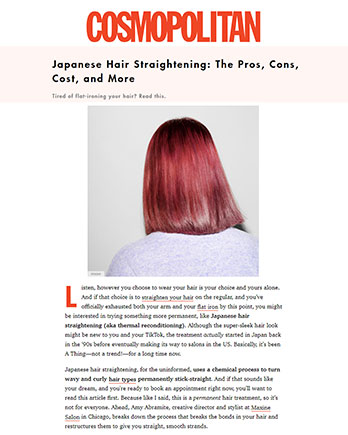Cosmopolitan May 28, 2021
Cosmopolitan
Beauty
Japanese Hair Straightening: The Pros, Cons, Cost, and More
Tired of flat-ironing your hair? Read this.
Listen, however you choose to wear your hair is your choice and yours alone. And if that choice is to straighten your hair on the regular, and you’ve officially exhausted both your arm and your flat iron by this point, you might be interested in trying something more permanent, like Japanese hair straightening (aka thermal reconditioning). Although the super-sleek hair look might be new to you and your TikTok, the treatment actually started in Japan back in the ‘90s before eventually making its way to salons in the US. Basically, it’s been A Thing—not a trend!—for a long time now.
Japanese hair straightening, for the uninformed, uses a chemical process to turn wavy and curly hair types permanently stick-straight. And if that sounds like your dream, and you're ready to book an appointment right now, you’ll want to read this article first. Because like I said, this is a permanent hair treatment, so it’s not for everyone. Ahead, Amy Abramite, creative director and stylist at Maxine Salon in Chicago, breaks down the process that breaks the bonds in your hair and restructures them to give you straight, smooth strands.
What is Japanese hair straightening?
As Abramite explains, Japanese hair straightening—or thermal reconditioning—is a permanent straightening treatment that removes 70 to 90 percent of curl, hair volume, and frizz by chemically restructuring your hair bonds. Here's how the process plays out: First, a solution is applied to your hair to chemically break its bonds to soften and straighten it. Then, your hair is rinsed, blow-dried, and flat-ironed to lock in the smoothness and shine. Next comes the neutralizer to help restore your hair's bonds and pH levels. Finally, your hair is again rinsed, blow-dried, and flat-ironed to finish.
Which is better, keratin or Japanese straightening?
Japanese straightening treatments leave you with straight, smooth, shiny hair that's much easier to blow-dry yourself, which is why it's commonly compared to a keratin treatment, which gives you very similar results. But here's the difference: While both treatments smooth hair and make blow-drying easier, Japanese thermal straightening is more intense.
Japanese hair straightening breaks your hair's bonds and reconfigures your hair permanently for maximum straightness. Keratin, on the other hand, temporarily reduces frizz by coating the hair, but it doesn't break or alter your hair's bonds. A keratin treatment leaves some curl and volume in your hair and gradually washes out over time, while Japanese hair straightening remains in the hair forever (or, ya know, until it’s cut off).
Get the difference, now? Cool, let’s get to know Japanese hair straightening a little bit better.
Is Japanese hair straightening bad for your hair?
As is the case with all bond-breaking chemical hair services, Abramite says, yes, there is a risk of compromising the integrity of your hair when you chemically straighten it. This, my friends, is why it's super important that you find a stylist with lots of experience in this process. If the technician is properly trained and the treatment is executed according to the manufacturer’s guidelines, Abramite says the hair should remain relatively healthy in the end.
Can you undo Japanese hair straightening?
With thermal reconditioning, the hair that has been treated is permanently straightened and will not wash out or wear off over time. If you change your mind, there is no Edit > Undo. Your only option is to grow it out and cut off the treated sections. To ease and smooth the growing out process and help with frizz and time with your hair dryer, Abramite recommends —you guessed it—a keratin treatment.
How long does Japanese hair straightening last?
Although Japanese hair straightening lasts forever, that doesn't mean it's a one-and-done process. Since your hair will still continue to grow, you'll need to touch it up after eight to ten months, or whenever you have four inches of new growth (which is the length needed for a proper product application and flat-ironing). To that end, Abramite explains that Japanese thermal straightening is best suited for wavy and curly hair patterns that are looser at the scalp, which allows for texture continuity between the treated hair and regrowth.
How much does it cost for Japanese hair straightening?
Brace yourself, because the price of Japanese thermal straightening starts around $700. It’s a time-consuming treatment, so the price reflects that, but your total cost will also depend on your stylist and the salon.
Should you wash your hair before Japanese hair straightening?
Please do! Abramite says the best way to prepare your hair for Japanese thermal straightening is to arrive with clean and air-dried hair in its natural texture. The process takes around four hours from start to finish, so arriving with prepped hair will reduce your time spent in the chair.
Can I tie my hair after permanent straightening?
For 72 hours after treatment, you've gotta wear your hair straight and down in all its glory and, just like a hair perm, keep it dry. Not only that, but your hair also needs to be kept free of tension or pressure caused by bobby pins, elastics, headbands, or anything else that could crease it. Abramite explains that during this delicate time, your hair is neutralizing and tension can leave an indentation behind for good. Once the waiting period is over, though, you're safe to return to shampooing and a regular haircare routine.
Is Japanese hair straightening worth it?
Just like how you choose to wear your hair, how you decide to spend your coin is up to you. If $700 is worth being able to wake up with straight strands each day and you’re willing to commit to the process and all the upkeep necessary to continue it or eventually grow it out, then it just might be. Only you (with advice from your hairstylist, of course) can make that call.

